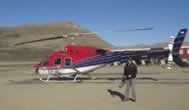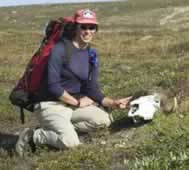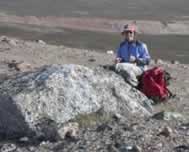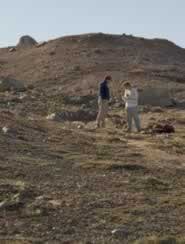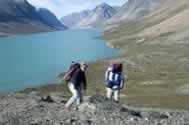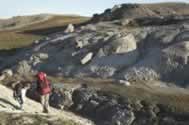14 Aug 04 – Arrive Constable Pynt and put in Camp 1
Brenda missed her flight on the 12th but arrived just in time for the flight to Constable Pynt the morning of the 14th. She spent a total of 2 hours in Iceland. We took a charter flight from Reykjavik to Constable Pynt and arrived in the late morning. Constable Pynt airport was bustling with a group of French passengers who were going onto the Tara, a French sailing ship. Finally, we met the security officer, Klaus, and he introduced us to the Danish Polar Center logistic coordinator, Aka. We had plenty of time to get our gear organized and packed because the helicopter ops could not begin until shuttle service from Constable Pynt to Scoresby Sund was completed. We also had the luck of getting a large block of cheese to take with us from the friendly cook at the station. At 19:00 we departed Constable Pynt and had the first views of Jameson Land and the Stauning Alper from the air. The first camp was located between Gurreholm Dal and Holger Danskes Briller (71°23.3 N, 24°44.6 W, 180 m.a.s.l). We discovered rings of boulders that showed that others camped there before.
15 Aug 04 –– The calibration walk
We began the day examining moraines west of Camp 1. We discovered that a tributary glacier had almost reached the well-defined moraines in the Holger Danskes Briller valley. First rock samples of the season were taken from boulders on outer moraines in Holger Danskes Briller valley. The last sample, acknowledged to be a “very hard rock” proved the need for a means to sharpen the chisels after use. This was our first experience conducting a “deep etching project” to retrieve the sample. Our first wildlife sighting was a lone musk ox on the valley floor. By early evening we needed to find an alternative stream crossing to return to camp. This was found at 23:20 well downstream from moraines. The distance on the air photograph did not seem like much, but it turned out to be 17.6 km and 1275 m of relief that we walked. Although we missed supper on this day, we got the benefit of two suppers the next day.
16 Aug 04 – The first shells – Gurreholm Slugt
Since supper was so early in the morning we had a later start toward the Gurreholm Slugt. We interpreted one area to be a moraine bank and found the first shell samples on a terrace along the river. At this site we also found a death assemblage – a collection of bones from small to large mammals. From there we followed the stream down and sampled shells at four sites. We began to realize the importance of colluvial processes in the region – where exactly are the shells coming from? Later in the afternoon we saw an arctic fox on the present outwash plain. It had been T-shirt weather early in the day, but we needed long sleeves by evening. We walked 11.6 km and 840 m of relief. The second supper of the day was later in the evening ~23:00, but at least on the same day.
17 Aug 04 – The long walk into Holger Danskes Briller
Since we now had the air photograph calibrated and a good stream crossing identified we decided to undertake a long walk to the moraine/ice-contact delta in the Holger Danskes Briller valley. The landform is classic in shape, but we could not find shells on it so we sampled three boulders on the ice-contact slope. Once the delta is dated, we can use these samples to cross-check the exposure technique. The last rock sample was relatively easy to dislodge. However, Tom?s hammering skills proved to get the best of the sample before it was finally retrieved. We had heard a strange noise that we thought was the call of a bird until we realized a fox on the delta was barking at us. The racket of our hammering had obviously upset him. He barked at us and followed us carefully until we left his territory. The return trip uncovered an extensive shell deposit about 68 m a.s.l. We saw a total of 5 mosquitoes, which we jokingly complained about, realizing the situation could be much worse. The stream crossing on the return to camp was much simpler with rubber boots. We walked 19.7 km and 980 m of relief. Supper was fashionably late, again on the same day.




